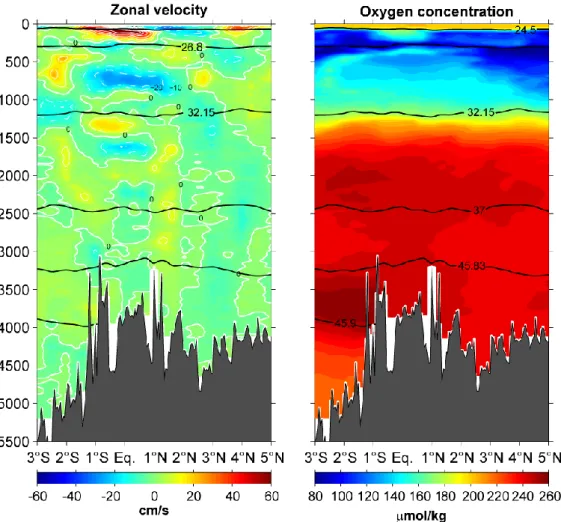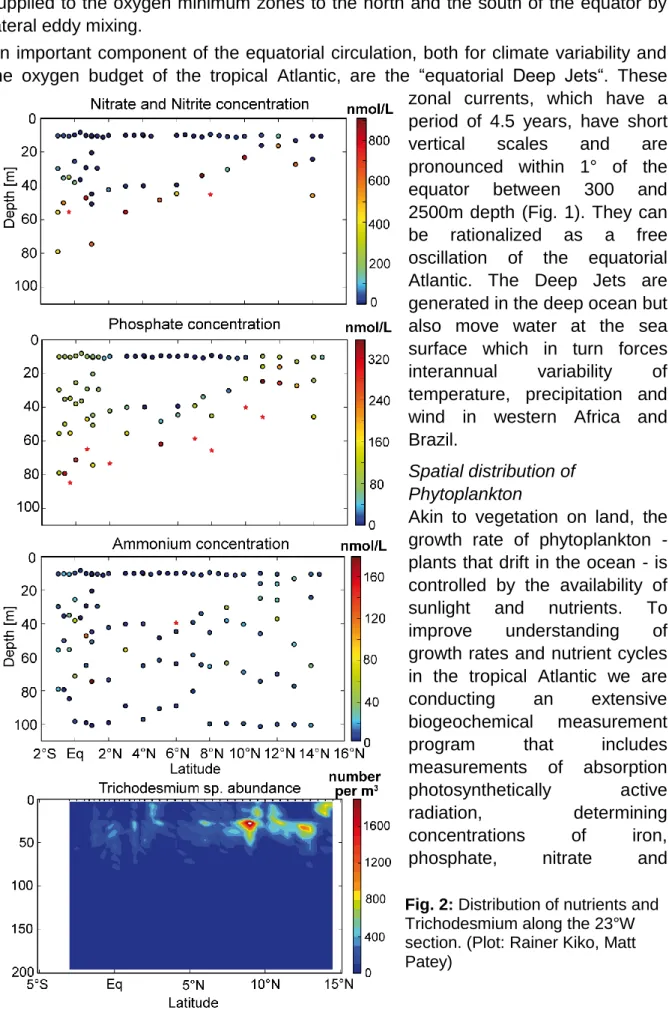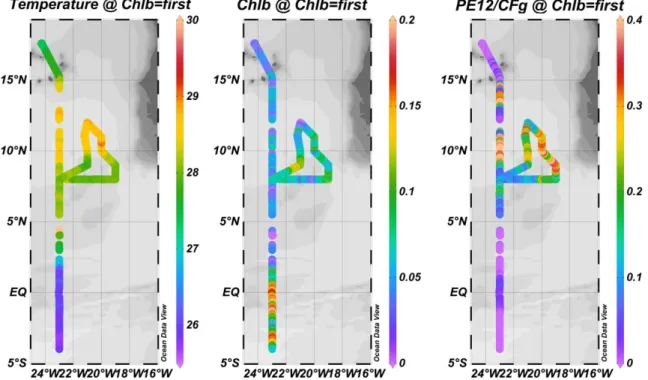Dr. Marcus Dengler Meteor Reise M130
M130, Mindelo – Recife
August 28th to October 3rd, 2016 4th Weekly Report, September 18th, 2016
During the 4th week our activities have focused on the equatorial region of the 23°W section and the recovery and deployment of a mooring on the equator. The physical and biogeochemical measurement program was successfully continued and we were particularly happy that all our instruments attached to the equatorial mooring returned full data sets. This includes a vertically-continuous velocity time series from the surface to a depth of 3500m.
Equatorial currents in the Atlantic
The equatorial circulation has been a research focus at GEOMAR for a long time.
The variability of the energetic zonal currents is linked to climate variability in the Atlantic sector. An improved understanding of the current variability will lead to improved medium-range climate predictions, particularly for western Africa and Brazil. Furthermore, the equatorial current system is important for the oxygen supply to the oxygen minimum zones. The eastward currents are linked to elevated oxygen
Abb. 1: Zonal velocity in cm/s (left panel) and concentration of dissolved oxygen in mol/kg (right panel) between 3°S and 5°N along 23°W. (Plot: Marcus Dengler)
Dr. Marcus Dengler Meteor Reise M130
Fig. 2: Distribution of nutrients and Trichodesmium along the 23°W section. (Plot: Rainer Kiko, Matt Patey)
concentrations and thus transport oxygen from the western boundary to the central and eastern equatorial regions (Fig. 1). Parts of this advective oxygen flux is then supplied to the oxygen minimum zones to the north and the south of the equator by lateral eddy mixing.
An important component of the equatorial circulation, both for climate variability and the oxygen budget of the tropical Atlantic, are the “equatorial Deep Jets“. These zonal currents, which have a period of 4.5 years, have short vertical scales and are pronounced within 1° of the equator between 300 and 2500m depth (Fig. 1). They can be rationalized as a free oscillation of the equatorial Atlantic. The Deep Jets are generated in the deep ocean but also move water at the sea surface which in turn forces interannual variability of temperature, precipitation and wind in western Africa and Brazil.
Spatial distribution of Phytoplankton
Akin to vegetation on land, the growth rate of phytoplankton - plants that drift in the ocean - is controlled by the availability of sunlight and nutrients. To improve understanding of growth rates and nutrient cycles in the tropical Atlantic we are conducting an extensive biogeochemical measurement program that includes measurements of absorption photosynthetically active radiation, determining concentrations of iron, phosphate, nitrate and
Dr. Marcus Dengler Meteor Reise M130
ammonium (Fig. 2) and sampling the distribution of Phytoplankton and its activity in the upper water column. The concentration of nutrients depends on several different factors. Iron is supplied predominately by the atmosphere, nitrate is fluxed upward from the deeper ocean predominately by mixing events and ammonium is predominately supplied from degradation processes of organic material.
As the cells of Phytonplankton strongly utilize nutrients in variable proportions, nutrient concentrations in the near-surface layers are small but vary along the 23°W section (Fig. 2). In the region between 10°N and 14˚N and at the equator between 2˚N and 2˚S, Phosphate concentrations in the near-surface layers are elevated but nitrate and ammonium concentrations are very low. These regions are characterized as upwelling regions, in which nutrient availability is relatively high and elevated growth rates of Phytoplankton are recorded. In these region, nitrate and ammonium are taken up in the deeper layers leaving a niche for nitrogen fixing organisms in the near-surface layer. An example of such an organism is the cyanobacteria Trichodesmium sp., which we found to be particularly abundant in the region between 10°N and 14˚N (Fig. 2, lower panel) using the Underwater Vision Profiler (UVP).
Similar to this system, we use an Aquatic Laser Fluoroscence Analyzer (ALFA) to determine the different phytoplankton species in the upper ocean. The ALFA distinguishes between Chlorophyll a and different Phycobiliprotein pigments from cyanobacteria.
First results show that the cooler surface waters north of 15°N host less phytoplankton and cyanobacteria than the region between 10°N and 14°N (Fig. 3).
Cyanobacteria are particularly elevated in the region of the warmer surface waters in the Intertropical Convergence Zone. The upwelling at the equator is dominated by Chlorophyll a (Fig. 3).
Apart from the ship-based measurements processed on board described above, sampling of dissolve iron concentrations in the surface waters and experiments to
Fig. 3: Sea surface temperature (left panel), chlorophyll a concentration (center panel) and Phybiliprotein concentration (right panel). (Plot: Ajit Subramaniam)
Dr. Marcus Dengler Meteor Reise M130
quantify nitrogen fixation and primary productivity are being conducted on board. The data, however, will only be available following extensive laboratory analysis at home.
We will have completed our measurement program along 23°W by Monday at noon.
After a 2.5 day transit, we are due to begin our measurement program in the western boundary regime of the coast of Brazil on Wednesday afternoon.
Best regards from the tropical south Atlantic, Marcus Dengler and the participants of M130


